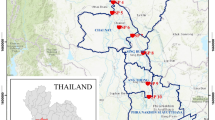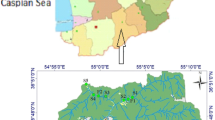Abstract
HUMAN activities have greatly increased the flux of many potentially toxic metals to aquatic ecosystems1. The development and implementation of effective remedial measures depend on our ability to predict the fate and effects of metals in these systems. Models based on sound physical-chemical and biological principles, such as the free-ion activity model2–5, have shown great potential as predictive tools. This model has been effective in explaining the central role of the free-ion concentration (or activity) as a regulator of interactions (uptake, toxicity) between metals and aquatic organisms2,3. It postulates that the biological effects of metals are best predicted by the activity of the free metal ion, rather than by total metal concentration. Because this model was developed in the laboratory under unnatural experimental conditions, it must be validated in field situations before being generally used in nature3. We report here that Cd concentrations in an indigenous aquatic insect larva, Chaoboruspunctipennis, are best described by the free-ion activity model, provided that competition for biological uptake sites between hydrogen ions and free cadmium ions, as well as cadmium complexation by natural organic matter, are explicitly taken into account. Our results suggest that the free-ion model would provide an effective theoretical framework for the use of animals as indicators of metal contamination in nature.
This is a preview of subscription content, access via your institution
Access options
Subscribe to this journal
Receive 51 print issues and online access
$199.00 per year
only $3.90 per issue
Buy this article
- Purchase on Springer Link
- Instant access to full article PDF
Prices may be subject to local taxes which are calculated during checkout
Similar content being viewed by others
References
Salomons, W. & Forstner, U. Metals in the Hydrosphere (Springer, Berlin, 1984).
Sunda, W. G. Biol. Oceanogr. 6, 411–442 (1992).
Campbell, P. G. C. Metal Speciation and Bioavailability in Aquatic Systems (eds Tessier, A. & Turner, D.) 45–102 (Wiley, New York, 1995).
Morel, F. M. M. & Hering, J. G. Principles and Applications of Aquatic Chemistry (Wiley, New York, 1993).
Sunda, W. G. & Huntsman, S. A. Limnol. Oceanogr. 28, 924–934 (1983).
Yan, N. D., Nero, R. W., Keller, W. & Lasenby, D. C. Holarctic Ecol. 8, 93–99 (1985).
Cusimano, R. F., Brakke, D. F. & Chapman, G. A. Can. J. Fish. Aquat. Sci. 43, 1497–1503 (1986).
Xue, H.-B. & Sigg, L. Water Res. 24, 1129–1136 (1990).
Goncalves, M. L. S., Sigg, L., Reutlinger, M. & Stumm, W. Sci. Total Environ. 60, 105–119 (1987).
Tipping, E. Comp. Geosci. 20, 973–1023 (1994).
Buffle, J. Complexation Reactions in Aquatic Systems: An Analytical Approach (Ellis-Norwood, Chichester, 1988).
Malcolm, R. L. Humic Substances in Soil, Sediment, and Water: Geochemistry, Isolation, and Characterization (eds Aiken, G. R. et al.) 181–209 (Wiley, New York, 1985).
Reuter, J. H. & Perdue, G. M. Geochim. cosmochim. Acta 41, 325–334 (1977).
Malcolm, R. L. Humic Substances in the Aquatic and Terrestrial Environment (eds Boren, H. & Allard, B.) 369–391 (Wiley, New York, 1991).
Boerschke, R. C., Galle, E. A., Belzile, N., Gedge, R. N. & Morris, J. R. Can. J. Chem. (submitted).
Stephenson, M. & Mackie, G. L. Aquat. Toxicol. 15, 53–62 (1989).
Hare, L., Carignan, R. & Huerta-Diaz, M. A. Limnol. Oceanogr. 39, 1653–1668 (1994).
Carignan, R., Rapin, F. & Tessier, A. Geochim. cosmochim. Acta 49, 2493–2497 (1985).
Hare, L. & Campbell, P. G. C. Freshwater Biol. 27, 13–27 (1992).
Tipping, E. & Hurley, M. A. Geochim. cosmochim. Acta 56, 3627–3641 (1992).
Author information
Authors and Affiliations
Rights and permissions
About this article
Cite this article
Hare, L., Tessier, A. Predicting animal cadmium concentrations in lakes. Nature 380, 430–432 (1996). https://doi.org/10.1038/380430a0
Issue Date:
DOI: https://doi.org/10.1038/380430a0
This article is cited by
-
Effect of cadmium exposure on antioxidant enzyme catalase in different tissues of Acrossocheilus fasciatus
Molecular & Cellular Toxicology (2016)
-
Metal Speciation in Sediment and Their Bioaccumulation in Fish Species of Three Urban Rivers in Bangladesh
Archives of Environmental Contamination and Toxicology (2015)
-
Watershed land use as a determinant of metal concentrations in freshwater systems
Environmental Geochemistry and Health (2009)
-
Antimony and Heavy Metals Accumulation in Some Macroinvertebrates in the Yesilirmak River (N Turkey) near the Sb-mining Area
Bulletin of Environmental Contamination and Toxicology (2007)
-
Phosphorus and Manganese Oxides Effects on Soil Lead Bioaccessibility: PBET and TCLP
Water, Air, and Soil Pollution (2005)
Comments
By submitting a comment you agree to abide by our Terms and Community Guidelines. If you find something abusive or that does not comply with our terms or guidelines please flag it as inappropriate.



